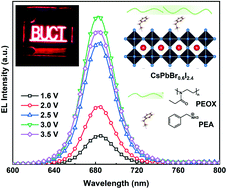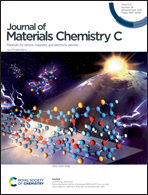High-efficiency red perovskite light-emitting diodes based on collaborative optimization of emission layer and transport layers†
Abstract
Metal halide perovskite light-emitting diodes (PeLEDs) are a new type of electroluminescent device with wide application in flat-panel displays and solid-state lighting. The charge recombination at the electrode interfaces and within the emission layer are the key factors restricting the performance of PeLEDs. In this work, the charge transport layers on both sides of the perovskite are optimized simultaneously to reduce the energy loss at the interfaces. Solution-processed aluminum-doped zinc oxide (AZO) nanoparticles are introduced as the electron transport layer in the traditional device structure, which effectively simplifies the device manufacturing process and greatly improves the device performance. Furthermore, an ultra-thin polymethyl methacrylate (PMMA) layer is introduced as a tunneling layer to reduce the exciton quenching between the hole transport layer and the perovskite emission layer. Poly(2-ethyl-2-oxazoline) (PEOX) is used as an additive to significantly enhance the solvent resistance of the perovskite layer. By collaborative optimization, a deep red PeLED emitting at 683 nm with a turn-on voltage of only 1.6 V and a maximum brightness of 7798 cd m−2 is achieved, providing a new idea for the development of high-performance all-solution-processed PeLEDs.



 Please wait while we load your content...
Please wait while we load your content...